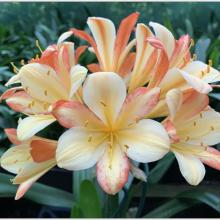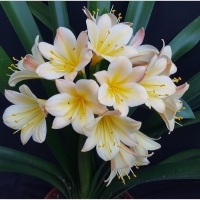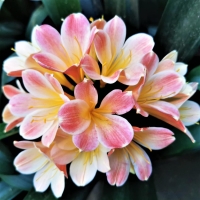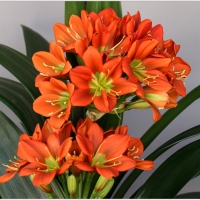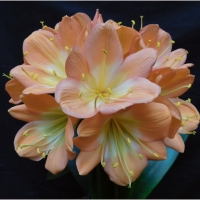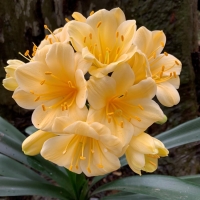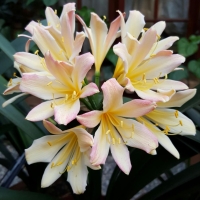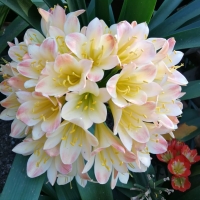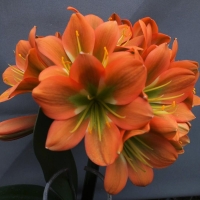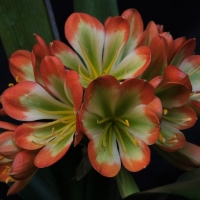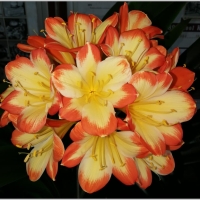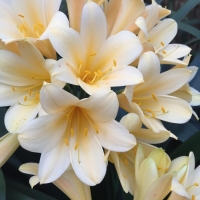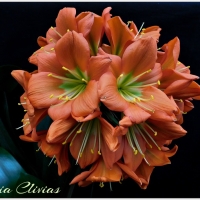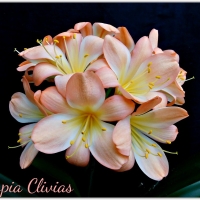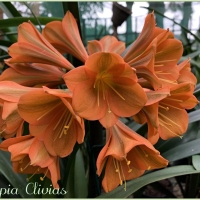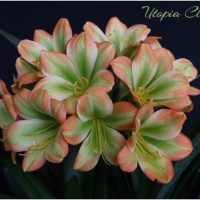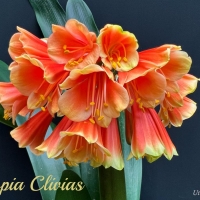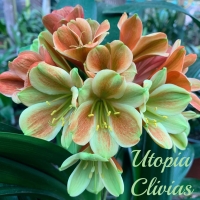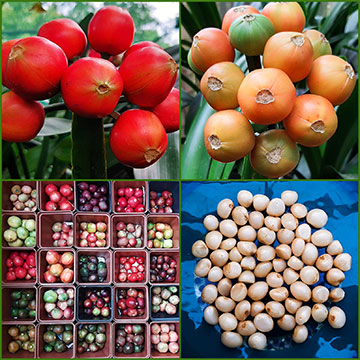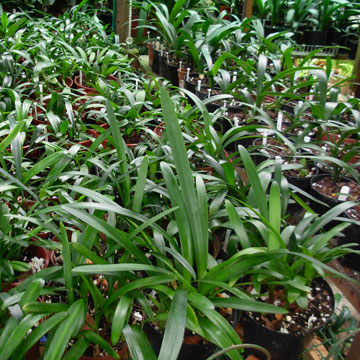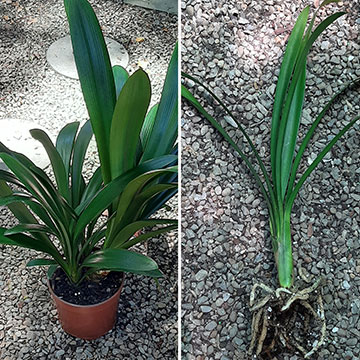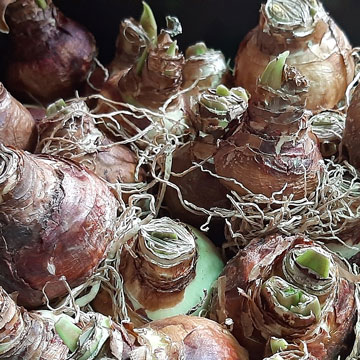“Some of our favourites”
By Luke and Carrie Krüger, Utopia Clivias
According to the Collins Dictionary, something “timeless” is a classic of some sort that is unchanged by time. It's just as good or true now as when it was created or discovered. The Clivias we have selected for these articles all fit this description perfectly, in that they are all exceptional in appearance and rarity that cannot be affected by changes in the Clivia industry. These plants have all been used extensively in breeding programs by various growers over the years and were all the first of a new breeding direction.
We have always enjoyed finding out more about the background of some of the exceptional Clivia plants. Learning about their origins, compatibilities when crossed with other plants, and features that they may contribute to their offspring. Making a choice of the plants we would like to write about has not been easy, as all breeders have their own particular favourites. We decided to make this a series of articles, highlighting interesting facts about the discovery of these plants. By making this choice, we do not imply in any way that these are the best breeding plants available, however they do form part of a group of exceptional plants that Clivia breeders have used to improve Clivia breeding.
This has been an interesting journey, involving many e-mails, phone calls and WhatsApp messages to breeders and although some of these plants seem to have come from unknown breeding, they have over time proved themselves as worthy breeding plants producing spectacular results for many growers.
1. Andrew Gibson
‘Andrew Gibson’ a habitat plant was acquired by Andrew Gibson and gifted (as a yellow and named Andrew Gibson) to Etzel Nuss in 1998 by Andrew Gibson. Andrew Gibson was a real estate agent specializing in farms and was an avid clivia breeder and collector. It is suggested that the first clone originated from a farm or forest in Karkloof, Kwa-Zula Natal, South Africa in the 1980’s. If it wasn’t for the friendship of Etzel Nuss and Andrew Gibson we may never have seen the plants.
Notable breeding from Andrew Gibson:
Royal Gala (Andrew Gibson x Naude’s Peach)
Fairytale (Msubo Wow x Andrew Gibson)
Splash (Line bred Andrew Gibson)
2. Autumn Whisper
Not much is known about Autumn Whisper and what you hear are only whispers, as most of the information has been lost in time. Autumn Whisper is an interspecific bred by the late Bertie Guillaume of Brom ‘n Nel Nursery, Louis Trichardt, Limpopo, South Africa. It was first pulled from the production lines of Brom ‘n Nel Nursery by his daughter Celia.
Autumn Whisper was first named ‘Stolen Bronze’ as it was liked by both Bertie Guillaume and his daughter Celia, and it was constantly ‘’moved’’ between their individual shade houses.
It was later renamed ‘Autumn Whisper’ by Celia.
It is speculated that is could be from Bertie’s Bronze breeding but like many other plants from the Guillaumes’ collection, its breeding history is unknown.
Autumn Whisper has bred some fantastic bronze interspecifics. Out crossing Autumn Whisper has produced the same.
Notable breeding from Autumn Whisper:
Autumn Angel (Bell Boy x Autumn Whisper)
Efydd (Small Bronze Green throat x Tropical Bronze)
Tropical Bronze (Berties Bronze x Autumn Whisper Seedling)
Autumn Crusade
3. Bella Donna Oprah
‘Bella Donna Oprah’ found its name in 2004, after careful selection by a panel of judges from the Clivia Society and the Oprah Winfrey magazine. This beautiful Clivia was named for Oprah Winfrey in 2004. Although others were considered, Bella Donna would reign supreme.
Bella Donna translated from Italian means ‘’beautiful lady’’. It is speculated that this plant was grown from seeds acquired from Mr Nakamura of Japan by the late Bertie Guillaume of Brom ‘n Nel Nursery, Louis Trichardt, Limpopo, South Africa. Unfortunately, the original breeding history is unknown.
This however did not deter growers from continuing the frantic pace of breeding with Bella Donna Oprah and its offspring.
It is a highly favoured plant for its unique breeding results.
Bella Donna Oprah is split for yellow and the green stemmed seedlings result in stunning compact yellow plants with large full umbels and giant flowers.
Notable breeding from Bella Donna Oprah
Bella Mia (Seedling of Bella Donna Oprah)
Bella Johan (Seedling of Bella Donna Oprah)
Bella Baby (Bella Donna Oprah x Cameo)
Bella Shae (Bella Donna yellow)
4. Brenthurst/Hantie
`Brenthurst/Hantie` comes from the gardens of the Brenthurst Estate owned by the Oppenheimers. The estate is located in Parktown, Johannesburg, Gauteng, South Africa. This plant was first spotted by Hantie Weitz while attending a function at the estate. The flowers are yellow with a touch of pink that matures to a darker pink as it ages. It was said that some of the plants in the Brenthurst gardens were obtained from the McNeils and could explain the compatibility with other Four Mary`s clones.
Superior clones have been bred from Brenthurst/Hantie.
Notable breeding from Brenthurst/Hantie:
Brenthurst x Hattori
Best Brenthurst
Hantie f2
5. Bronze Green Boy
Bronze Green Boy as it was so aptly named was discovered in September of 1998 by Ian Vermaak and his then wife Geraldine Vermaak while walking their dog. It was discovered in the garden of a Mr. & Mrs. Slabbert in George, Western Cape, South Africa. It was spotted among the orange clivias and stood out immediately. Hannes (Mr. Slabbert) told Ian Vermaak that it was acquired at a nursery in Johannesburg before moving down to George. An offset was offered to Ian Vermaak, and it would flower 2 (two) years later. Ian Vermaak was to name it ‘Chardonnay’ but after discussions with Hannes and Louis Swanepoel the name of ‘Bronze Green Boy’ was decided upon.
Bronze Green Boy was taken to the Cape Town clivia show in September of 2000 where it was a huge hit. Never before has a clivia with such remarkable colour been seen by both public and breeders alike. Bronze Green Boy has gone on to win multiple ‘Best on Show’ awards for years to come and to this day still stands tall among all the other bronzes.
Breeding with Bronze Green Boy has been a challenge for many, in that (Bronze Green Boy) is self-sterile and has an extremely poor seed set even when pollinated with other pants. But through the struggle growers have had moderate success with Bronze Green Boy.
Dawie Strydom of South Africa has had success in the 2nd generation with Bronze Green Boy on to multi-tepals see ‘Clivia Yearbook 21, Pg.26-30’.
Notable breeding from Bronze Green Boy:
DS Bronze - (BGB X McNeil Bronze)
Multi tepal bronze
6. Cameo
‘Cameo’ was a hand selected seedling, chosen and named by Liz Boyd. It was bred by the late Bertie Guillaume of Brom ‘n Nel Nursery, Louis Trichardt, Limpopo, South Africa. Cameo’s breeding history is unknown, but being split for yellow opens doors for breeders, and the possibilities are endless.
‘’A cameo” is a form of glyptography or carving, cut into a variety of materials, but most often into glass, hardstones, and shells. These detailed reliefs were often used to adorn pieces of jewellery, such as brooches, necklaces, bracelets, and rings.’’ In this instance the colour of a brooch after which Liz named her plant.
It has been proven to be a very worthy breeding plant in any collection.
Notable breeding from Cameo
Cameo Supreme (The best Cameo Plus)
Cameo Plus
Bella Cameo (BDO x Cameo)
Sunkist (Cameo Yellow)
7. Charl’s Green
‘Charl’s Green’ was one of the first green Clivias available in South Africa many years ago. Charl’s Green was sold for R32 000 at the 2006 Clivia conference held in Pretoria, South Africa. At that time, it was the highest price paid for a Clivia in South Africa. Prior to the auction, Charl’s Green was originally named “Green Lady”, but then renamed ‘’Charl’s Green’’ by Charl Coetzee after he acquired it from Charl Malan from Grahamstown.
Charl’s Green followed the same route in history as Star Green. In 1997 Charl Malan received seed from Mr. Nakamura of 31 different crosses. Charl Malan and Philip Crous (Charl’s neighbour) simply numbered the batches 1-31. Batch no.13 was described by Mr. Nakamura as “Special Seed”. Charl Malan grew 15 from this batch and Philip Crous grew the other 9 seeds. From this batch (No.13) Charl`s Green would emerge.
Notable breeding from Charl’s Green
“Ice Ice Baby” (Vico Yellow x Charl’s Green) x Charl’s Green
Charlston (P8/Shimmer x Gunston) x Charl’s ‘Green
Iced Beauty (Coromandel yellow x Charl`s Green x sibling)
8. Crown Prince
‘Crown Prince’ is a dark bronze bred by the late Bertie Guillaume of Brom n Nel Nursery, Louis Trichardt, Limpopo, South Africa. This was a seedling selected by Celia out of the breeding house. It was named Crown Prince because it stood out like royalty among the other plants. Breeding history is unknown. This plant started Celia`s “Africa Range” of bronzes.
Notable breeding from Crown Prince:
Crown 7 (Crown Prince x 777)
Gothic (Crown Prince f1 x Hirao)
9. Deklan
‘Deklan’ is a plant with a beautiful head of recurved pastel pink flowers bred by the Late Johannes Boshoff de Kock (Bossie De Kock). Deklan was named after Bossie De Kock`s son. The breeding is unknown, but has been proven to split for grp.1 yellow. Deklan breeds beautiful recurved pinks and pastels. This plant was first featured on the cover of the Clivia Yearbook 6.
Notable breeding from Deklan:
Deklan`s Virtue
Deklan`s Dignity
10. Four Marys
‘Four Marys’ is a series of plants originally obtained from Margot and Gordon McNeil. The flowers are narrow tepal yellow or near white and turn pink when they age. Margot McNeil mentioned that Gordon named the plant Four Marys after the ladies in waiting of the Queen Mary of Scots. They are known in history as ‘The Four Marys’; Mary Seton, Mary Fleming, Mary Beaton and Mary Livingston. The number four was used for the four colours seen with the flowering of Four Marys.
Notable breeding from Four Marys:
Paljas Magic (Jumbo Yellow x Four Marys x siblings)
Monet (Four Marys seedling)
Lady Jane (A selected Four Mary’s)
Gordonia (Four Mary`s Seedling)
11. Gunston
In 1997 Pikkie and Elize Strumpher travelled to Fronehave Nursery near Badplaas also known as eManzana and eBhadini is a small town on the R38 road in eastern Mpumalanga, South Africa. At the nursery they spotted a bronze flowering clivia. This clivia was named G06. The plant had been pollinated at the nursery and developed berries. Pikkie germinated the berries and the offspring were named Gunston Brothers.
At the Metro Show in 2001 ‘Gunston’ was awarded ‘Second Best on Show’. The late Koos Geldenhuys, one of the judges present for the plant judging suggested the name ‘Gunston’, as the colour of the flower was the colour of a packet of Gunston cigarettes.
Notable breeding from Gunston:
Mrs. Brown
Gunrao
African Princess
Janneman
“Classics” series
12. Klein Erda
‘Klein Erda’ is a plant grown from Nakamura seeds by the late Bertie Guillaume of Brom `n Nel Nursery, Louis Trichardt, Limpopo, South Africa. This plant was very special to Bertie Guillaume and his late wife Erda Guillaume, as it was named after their granddaughter Erda (now Erda Ferreira Coxen). It is an orange-coloured flower with a white throat, now classified as a bicolour. This plant has proven itself as noteworthy breeding plant in many collections.
Notable breeding from Klein Erda:
Play Erda- Best on show NCCK show 2018
David
f1 USA orange x Klein Erda
13. Naude’s Peach
‘Naude’s Peach’ originally belonging to Olive and Stoffel Naude was discovered in 1977 by Mrs. Olive Naude in a neighbour’s garden in Kloof, KwaZulu-Natal, South Africa. Their neighbour had a large number of ‘’yellows’’ flowering in her garden and upon her untimely death a single plant was obtained by Olive and Stoffel. This was potted up and flowered with 2 peduncles yearly.
Naude’s Peach was first entered into the Natal Clivia show in 1996/7 by Olive Naude, the only other mutation around was Chubb’s peach. It opens up yellow and matures to a light pink/peach on the outside of the tepals, and was therefore named Naude’s Peach. It is now it is classified as a versicolour belonging to the ‘’Splash group’’. Although the original Naude`s Peach flowers are not anything spectacular, it has proven to be one of the best breeding plants around.
Although Naude’s peach is an anomaly, it has the proven potential to breed amazing crosses.
Notable breeding from Naude’s Peach:
Pastel Blush (Group 2 yellow x Naude’s Peach)
Narcotics Series e.g., Zol, Daggakoekie
Royal Gala (Andrew Gibson x Naude’s Peach)
Blushed Yellows
14. Sleeping Beauty/F14
‘Sleeping Beauty/F14’ was purchased from the collection of the late Nico Frik for Swellendam Western Cape, South Africa, a good friend of the late Johan Conradie. All of Nico Frik’s plants +-30 were sold to Johan Conradie. He numbered them F1, F2 etc (Frik 1, Frik 2). One of these plants was F14 (Frik 14). A big plant with leathery thick leaves, even the roots were thicker than usual.
Sleeping Beauty was named after the mountain in Riversdale, South Africa, and has much significance as to the naming of the plant. Johan Conradie grew up next to the hanging mountains of Garcia Pass, Riversdale in a small place called Novo. Another reason it was called “Sleeping Beauty” is it would easily skip 3 or 4 years between flowering, it would slumber until it felt the need to flower. After many years it finally flowered and subsequently won the Garden Route Clivia Club ‘Best on Show’ in 2007. After this it gained the attention of many Clivia growers especially that of Aart van Voorst of the Netherlands who took the pollen to a lab (to have it tested) where it was confirmed to be a tetraploid.
Seed set on Sleeping Beauty is near impossible. The pollen is infertile on plants that are not tetraploids, the seeds look as if they have set but are soft mushy and struggle to germinate. Sleeping Beauty`s offspring are slow growing and take many years to mature and flower.
15. Star Green
‘Star Green’ is an unusual green versicolour with red/brick on the outer petals. The name “Star Green” was randomly chosen by Phillip Crous because of the green undertones. Star Green is a slow grower and it does not self-pollinate easily. When pollen is used on other plants, seed set is also poor.
In 1997 Charl Malan received seed from Mr. Nakamura of 31 different crosses. Charl Malan and Philip Crous (Charl’s neighbour) simply numbered the batches 1-31. Batch no.13 was described by Mr. Nakamura as “Special Seed”. Charl Malan grew 15 from this batch and Philip Crous grew the other 9 seeds. From this batch (No.13) Star Green, Charl`s Green and Cromwell Bronze would emerge. This confirms that these plants are siblings.
These plants are now in the hands of a lucky few breeders to take breeding one step further.
Notable breeding from Star Green:
Star Green Destiny
Charl’s Green x Star Green (Bronzes)
Star Power
16. Warmheart
Warmheart is one of those timeless classic Clivias. Bred by the late Wessel and Rudo Lotter, this interspecific has proven to be an asset to any breeder`s collection.
The name is a very accurate description of the colour of this flower. It is a versicolour, but as it matures the inside of the tepals develop a warm red glow. It is speculated to be a f2 caulesescens interspecfic hybrid.Notable breeding from Warmheart:
Arishook
Shen
Sheriba
Thank you to all contributors:
Liz Boyd, Val Thurston, John Handman, Pieter Saayman, George Mann, Dawie Strydom, Ricky Jardim, Norman Weitz, Francois van Rooyen, Sean Chubb, Pikkie Strumpher, Chris Smit, Charl Malan, Wouter Conradie, Aart van Voorst
Clivia news Vol.17 No.3-4 2008 pg.23 ‘Andrew Gibson’ by Etzel Nuss
Clivia news Vol.25 No.1-2 2016 pgs. 14-18 ‘Andrew Gibson’ breeding by Rouzell van Coller
Clivia Yearbook 7 pg.49 Clivia miniata 'Bella Donna Oprah' by Ajam, Kashiefa
Clivia Newsletter Vol.13 No.1 2004 pg.11-12 Correspondence of Jane Raphaely Editor: The Oprah Winfrey Magazine, John Winter and Clivia Society PRO Cobus Roos
Clivia Newsletter Volume 12 No.4 pgs. 9-10 2003 The story behind ‘Bronze Green Boy’ by Ian Vermaak
Clivia Yearbook 21, Pg.26-30 by Dawie Strydom
Clivia Yearbook 9 pg.112 Charl's Green: The coolest clivia by John van der Linde
Clivia newsletter vol.27 no.3 pgs.6-14 2018 ‘Paljas Magic – A new colour strain’ by Dawie Strydom
Clivia newsletter vol.21 no.3 pgs.18-20 2012 ‘Breeding green throats’ by Pikkie Strumpher
Clivia news Vol.24 No.1 2015 pg.15-18 ‘A Star is Born’ by Carrie Krüger, Utopia Clivias
https://cliviasociety.com/clivia-register/clivia-register-detail/?pdb=2521
https://www.facebook.com/clivias2go/photos/a.223890504781372/329084917595263/
https://cliviasociety.com/clivia-register/clivia-register-detail/?pdb=1889
https://www.iol.co.za/news/south-africa/prize-clivia-auctioned-for-record-amount-2931
https://www.iol.co.za/news/south-africa/a-flower-for-a-bella-donna-226260
http://www.cliviaforum.za.net/forum/index.php?topic=4608.0
http://www.cliviaforum.za.net/forum/index.php?topic=4828.0
http://www.cliviaforum.za.net/forum/index.php?topic=26632.0
http://www.cliviaforum.za.net/forum/index.php?topic=9028.15
http://cliviasa.co.za/index.php/naude-peach
